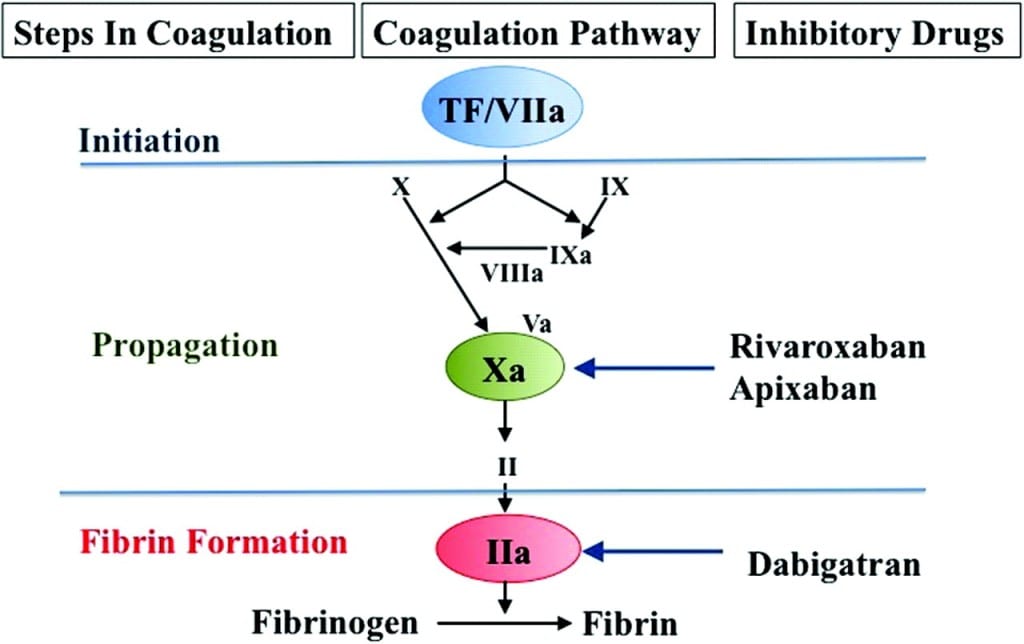
 So you are minding your own business working in the ED at Big Hospital, when two dudes (paramedics) bring in a patient with abdominal pain. As luck would have it, this person has a perforated bowel and needs surgery pretty quickly. AND they are on, yes you guessed it… Wait for it… Dabigatran! You consult your local surgeon and she scratches her scrub cap. “I may not want to take that person to surgery? Let me check with my resources and get back…”
So you are minding your own business working in the ED at Big Hospital, when two dudes (paramedics) bring in a patient with abdominal pain. As luck would have it, this person has a perforated bowel and needs surgery pretty quickly. AND they are on, yes you guessed it… Wait for it… Dabigatran! You consult your local surgeon and she scratches her scrub cap. “I may not want to take that person to surgery? Let me check with my resources and get back…”
If you are like me, you are seeing more and more patients on Dabigatran. This drug is touted to be superior to traditional warfarin for reduction of stroke in atrial fibrillation patients (Ruff 2014) and has had a lot of momentum by many other studies.
To Review Dabigatran:
- Oral direct thrombin inhibitor
- 3 hrs peak onset. Half life 12-24hrs
- Approved for stroke prevention in patients with nonvalvular atrial fibrillation.
- Renal excretion
- Unable to be reliably monitored – Low aPTT and Thrombin Time (TT) may correlate with lower levels. (Dager 2011, Hapgood 2013)
- More predictable and no monitoring needed (Loved by cardiologists and internists)
- Unable to be reversed (Despised by resuscitationists and surgeons)

Image from DVT – Venous Thromboembolism 2012
You scramble to your trusted EM reference library and you just so happen to have the most updated versions of our trusted textbooks. You do some investigating:
- Tinitnallis 7th edition 2011. Not mentioned.
- Rosens 8th edition 2014. Not mentioned.
Your surgeon looks into her text book (Shwartz’s Principles of Surgery 10th edition circa 2014) and they actually mention the NOAC’s: “…these drugs, have no readily available method of detection of the degree of anticoagulation. More concerning is the absence of any available reversal agent…is of great concern to those providing emergent care to these patients. The only possible strategy to reverse the coagulopathy associated with dabigatran may be emergent dialysis. Unfortunately, the ability to rapidly dialyze the hemodynamically unstable bleeding patient or rapidly dialyze the anticoagulated patient with an intracranial bleed is challenging even at large medical centers. In less urgent states, these drugs can be held for 36 to 48 hours prior to surgery without increased risk of bleeding in those with normal renal function. Alternatively, activated clotting time (stand alone or with rapid TEG) or ecarin clotting time can be obtained in those on dabigatran…”
So your surgeon washes their hands of the patient telling you to “call nephro or someone else, I ain’t gonna’ cut till this gets sorted out!”
So what do you do?
You do a search dabigatran surgery and find a few FOAMed posts and the following article:
Schulman S et al. Perioperative Management of Dabigatran: A Prospective Cohort Study Circulation May 2015. 132 (3): 167 – 73. PMID: 25966905
What They Did:
- Canadian multicenter prospective cohort study. Non industry sponsored study. (Many authors had listed COI with the maker of Dabigatran Boheringer Ellingham.)
- They followed 541 surgical cases: 324 with standard risk of bleeding and 217 with increased risk of bleeding. Mostly old men avg age 72 and 70% male.
- They divided patients up by CrCl (creatinine clearance), timing of last dose of dabigatran before surgery, and major vs minor cases.
- Divided procedures: Standard risk of bleeding or High risk of bleeding.
- They compared groups who stopped Dabigatran depending on CrCl and risk of bleeding at:
- 24hrs (46% of patients)
- 48hrs (37% of patients)
- 96 hrs (6% of patients)
Outcome: Major or minor bleeding 30 days post procedure.
Results:
- 10 pts (1.8%) had a major bleeding event
- 8 of these were classified as high risk procedures
- 6 cases managed with transfusion of PRBCs alone
- 28 patients (5.2%) had 35 separate minor bleeding events
- 21 of these episodes were at the surgical site
Back to Our Case: The patient in question has an aPTT of 29. They have a normal Cr and Cr Cl of >80 and didn’t take their Dabigatran this morning. Their last dose was 24hrs ago.
You discuss the case with the surgeon and she reassesses the pt. They understand the risks and consent to surgery.
So in the end of this clinical fairytale case, they go to surgery having <2% chance of major bleeding 5% minor bleeding. Most of the time should live happily ever after.
My take on the above study: Many have talked about attempts to reverse Dabigatran in life threatening acute bleeds. This Study deals with the clinical scenario of patients on Dabigatran who will need procedures/surgeries in the near future but not warrant immediate reversal (as if one exists). This is a fairly good prospective validation of a prior clinical recommendation that may find a place in our clinical practice.
My problems with the study are:
- Anytime we have a subjective, observational report there is room for bias with confounders not taken into account. The bias may be with this set of authors (they are industry supported) and has to be recognized. Independent, blinded, unbiased verification would be best.
- 4% of patients had meds held beyond the recommendation under scrutiny which isn’t adhering to the protocol and dilutes the conclusion. I think those patients should have been excluded since they went outside of the protocol. This would make the reported bleeding rate higher.
- This study is primarily weighted in the elderly who have more complications than younger patients.
One Last Caveat:
In patients with major bleeding or if Dabigatran was stopped late in association with emergency surgery, more active management may be required…
- Hemodialysis (Warkentin 2012)
- 4 Factor or Activated Prothrombin Complex Concentrate (FEIBA) (Diaz 2013, Schulman 2014)
- Recombinant Factor VIIa – rFVIIa (van Ryn 2010)
- Idarucizumab (Pollack 2015, Glund 2015) – If you believe all the hype!!!
Clinical Bottom Line: We can still operate on patients with Dabigitran when we understand and interpret its pharmokinetics and effects. This article, and others, should be brought up before the surgeon washes their hands of the patient on the phone after hearing “the patient is on Dabigatran.” Anytime a person is taken to surgery there are risks and benefits. Nobody is zero risk. The shared decision making of the patient on Dabigatran and surgeon is critical.
References:
- Ruff CT, Giugliano RP, Braunwald E, et al. Comparison of the efficacy and safety of new oral anticoagulants with warfarin in patients with atrial fibrillation: a meta-analysis of randomised trials. Lancet. 2014;383(9921):955-962. PMID: 24315724
- Dager WE, Gosselin RC, Kitchen S, Dwyre D. Dabigatran effects on the international normalized ratio, activated partial thromboplastin time, thrombin time, and fibrinogen: a multicenter, in vitro study. Ann Pharmacother. 2012 Dec;46(12):1627-36. doi: 10.1345/aph.1R179. Epub 2012 Dec 11. PMID: 23232017.
- Hapgood G, Butler J, Malan E, Chunilal S, Tran H. The effect of dabigatran on the activated partial thromboplastin time and thrombin time as determined by the Hemoclot thrombin inhibitor assay in patient plasma samples. Thromb Haemost. 2013 Aug;110(2):308-15. doi: 10.1160/TH13-04-0301. Epub 2013 Jun 20. PMID: 23783268.
- Schwartz’s Principles of Surgery 10th edition Ch 4 Mcgraw Hill 2014
- Tintinalli’s Emergency Medicine A Comprehensive Study Guide 7th edition Mcgraw Hill 2011
- Rosen’s Emergency Medicine Concepts and Clinical Practice 9th edition Mosby 2014
- Steiner, T., et al., Recommendations for the emergency management of complications associated with the new direct oral anticoagulants (DOACs), apixaban, dabigatran and rivaroxaban. Clin Res Cardiol, 2013. 102(6): p. 399-412. PMID: 23669868
- Hawes, E.M., et al., Performance of coagulation tests in patients on therapeutic doses of dabigatran: a cross-sectional pharmacodynamic study based on peak and trough plasma levels. J Thromb Haemost, 2013. 11(8): p. 1493-502. PMID: 23718677
- Schulman S et al Perioperative Management of Dabigatran: A Prospective Cohort Study Circ. May 2015.132 (3): 167 – 73. PMID: 25966905
For More on This Topic Checkout:
- Scott Weingart at EMCrit: Bleeding Patients on Dabigatran aka Pradaxa
- Ryan Radecki at EM Lit of Note: Let’s Reverse – Dabigatran
- Cliff Reid at Resus.ME: Dabigatran Reversal Agent – Idarucizumab
The post Dancing with the Devil: Taking Dabigatran to the OR appeared first on REBEL EM - Emergency Medicine Blog.
